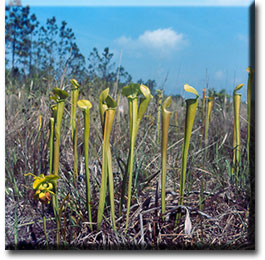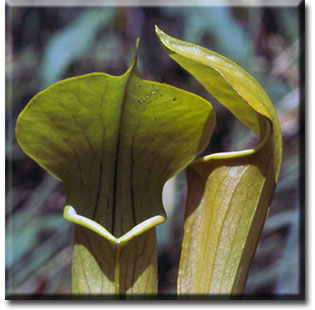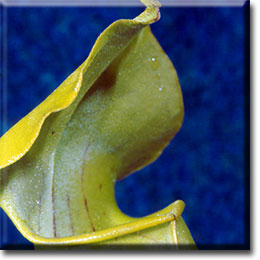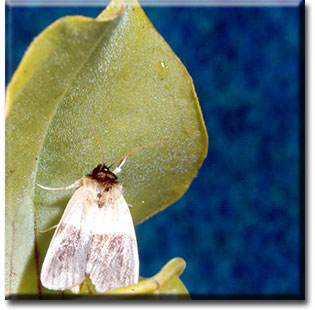Sarracenia alataCarnivorous Plants / Insectivorous Plants
The North American pitcher plants (Sarracenia) are divided into two groups: the northern pitcher plant (Sarracenia purpurea), in the northern United States and adjacent Canada, and the southeastern pitcher plants. Sarracenia alata is one of the southeastern pitcher plants, and can be found from eastern Texas to Mississippi. Here's a picture of it near Mobile, Alabama. At first glance, one only sees the pines, and pine forests in areas of white sand that stay wet in the summertime are habitats for most of the southeastern pitcher plants.
If you're looking for Sarracenia alata, you want to look for areas of pine forest. Not dense pine forest, but pine forest with meadow-like openings in it. These areas are waterlogged even in summertime because there are dense soils (clays, for example) underneath the white sand, so that water forms shallow pools or isn't far beneath the surface. These areas are acid--pines are good indicators of acid). And these boggy areas are poor in nutrients, notably nitrogen. The pitcher plants can get enough nitrogen from digesting insects to make up for the lack of nitrogen in the soil. Each tubular pitcher (leaf) contains a small pool of water, which contains insect-digesting chemicals (enzymes) at the bottom of the tube. Here we see a flower and three leaves of Sarracenia alata. The leaf at left hasn't opened yet. The leaf in the middle is seen from the front. Notice the light green zone like a V at the mouth of the pitcher--that's where an insect lands and begins its exploration of the pitcher. It's looking for nectar droplets on the inside of the hood of the pitcher. Extending down from the V is a dark narrow fold that represents the margins of the leaf--as though they were sewn together like the seam in a cushion. The word "alata" in Latin means "winged," and this narrow wing on the front of the pitcher gives the plant its name. The leaf at the right is seen from the side, and we can see that the tip of the leaf forms a hood that overarches the mouth of the pitcher. The hood helps guide the insect to climb down into the tube, and it may also prevent rainwater from diluting the digestive fluid in the pitcher. 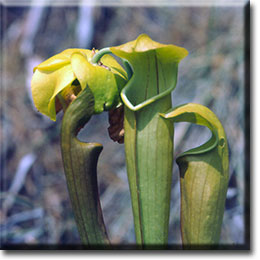 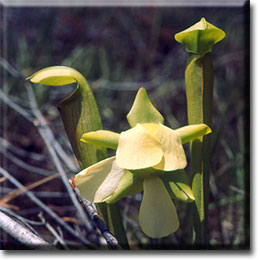 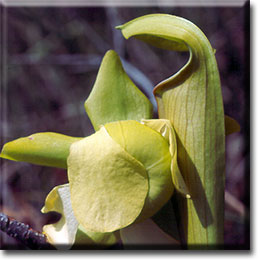
The flowers of Sarracenia alata are big compared to the leaves--just one flower per stalk. One petal of this flower has been pulled down (bottom of picture) to show its shape. The petals don't open out flat, and tend to hang down. The sepals, which are greener and more pointed than the blunt, yellow petals, may add more color to the flower and help attract a pollinator.
Here's a flower that is beginning to open. At this stage, the petals are still folded over each other. Yellow is a color that is attractive to bees. The flowers of Sarracenia alata are large, so one might expect a large bee to pollinate this flower. In fact, bumblebees (Bombus) are known to visit the flowers of Sarracenia and to pollinate them. If you look at the leaf at left, you can see a small point at the tip that tells you that this really is a kind of leaf--it has a tip as other leaves do. The wide flaring hood of the pitcher is also like the flat part of a leaf. So if you took an average wide but flat leaf from a number of different plants and rolled up the tip, you could make something that looks like the pitcher of Sarracenia. The leaf at right in this picture shows reddish veins on the outside. Reddish lines may help attract insects to the pitcher. The hood of Sarracenia alata is the beginning of the insect trapping process. The insect sees things that you can't see in this picture, or can't see very well. There are droplets of nectar on the inside of the hood. Insects that are accustomed to finding nectar in flowers are fooled, and begin to feed on the nectar on the hood of the pitcher. There are downwardly-pointing hairs. These lead the insect downwards, but prevent it from climbing back up. The surface of the hood also has waxes (whitish area) on it, and an insect loses footing on the smooth wax and falls into the pitcher. You can se some red lines leading downward into the pitchers. Some insects follow lines like this, and thus tend to go into the pitcher.
There's an insect that doesn't get caught in the Sarracenia pitchers: the Exyra moth. Exyra moths spend almost their entire life cycle in the pitchers of Sarracenia. The legs of Exyra moths can cling to the surfaces of Sarracenia pitchers without falling, and Exyra can climb over the downwardly-pointing hairs and aren't forced downward into the pitcher. Why do Exyra moths live in the pitchers? They feed on the tissue of the pitchers. This explains why the Exyra moths tend not to leave the pitchers. Here's a mature fruit of Sarracenia alata. The fruits are dry at maturity and open by splits. The seeds shake out of the fruit through these splits--probably helped by wind, which tends to shake the seeds out. Fruits that disperse seeds when there's a wind have a good strategy: the seeds are carried farther on a windy day. The seeds of Sarracenia, much enlarged here, have extremely tiny warts on them. Nobody knows how these seeds are dispersed--one of many questions about plants that haven't been answered. Sarracenia seems to do best in areas that burn occasionally. Do the seeds of Sarracenia resist fire? Do they even germinate better after a fire? These are more questions that would be interesting to study. Some people have the idea that we know everything worth knowing about plants. Wrong! We begin to learn more every time we ask a new question. 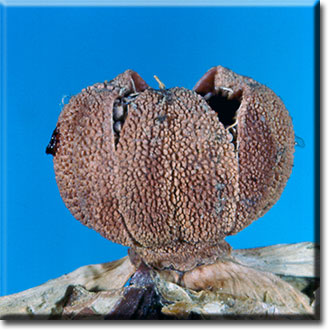 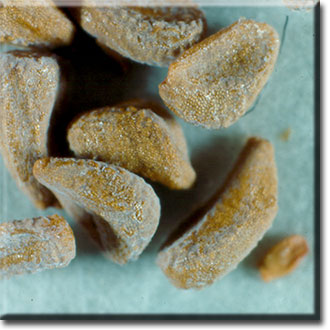 Thank you to Dr. Sherwin Carlquist for the images and content, and to Drs. Chris Martine and Maggie Koopman for the video! |
